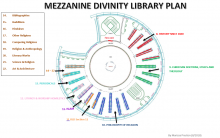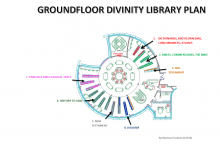Finding books
All Divinity Library books can be found on the University's online catalogue iDiscover. You can search our catalogue from anywhere in the world or via computers in the Library. Need help with iDiscover? Please look at https://libguides.cam.ac.uk/idiscover or ask a member of Library staff for assistance.
Books are arranged in the following sections:
 |
|||
|
1 |
Dictionaries, encyclopaedias, grammars, atlases, concordances |
8 |
History since 1600 |
|
2 |
Bible as a whole, plus Bibles & commentaries |
9 |
Christian doctrine, ethics & theology |
|
3 |
Old Testament | 10 |
Philosophy of religion, social science, science & religion, ethics, literature1 |
|
4 |
Judaism |
11 |
Old section 11 [nothing added to it any more since March 2016]2 |
|
5 |
New Testament |
11A- 11S |
Islam |
| 6 |
History to 1600 |
12 |
Liturgy & worship, homiletics, ecclesiology |
|
7 |
Patristics and classical texts |
13 |
Periodicals |
|
|
|
14 |
Bibliographies, librarianship |
| 15 |
Buddhism |
||
|
|
|
16 |
Hinduism |
|
|
|
17 |
Other religions or religious movements |
|
|
|
18 |
Comparing religions / dialogues between them / inter-faith |
|
|
|
19 |
Religion & Anthropology, politics, society & gender |
|
|
|
20 |
Literary works |
|
|
|
21 | Science/ Science and Religion |
|
|
|
22 |
Art and architecture |
The class mark usually consists of the section number followed by the first few letters of the author’s name, except in Section 1 and for pamphlets where the first 3 letters of the title are used. Commentaries in Section 2 are arranged by series.
Since October 2015, we have started adding a running number to newly-acquired and existing books, and have also been more consistent in highlighting secondary literature by the “name of the writer/theologian” (4 letters) plus scholar’s name (3 letters). The volume number within a multi-volume work is captured by using a dot and the number. Where multiple copies of a book exist, these are indicated by the copy number in square brackets. Sadly, all this is still a work in progress (as of September 2020), and will remain to be on our to-do list for at least 10 to 15 further years.
Before May 2016 any newly-acquired books relating to religion & anthropology, politics, society & gender went into section 8 or 10. Since then we have put them into the (newer) sections 18 and 19; many previously-acquired books remain in sections 8 and 10. Equally, all newly-acquired books relating to Buddhism, Hinduism and other religions or religious movements have been placed into their own sections 15, 16, and 17, since May 2016 . A fair number of previously-acquired books covering religions and religious movements are still in the old section 11. Islam was moved into the new section 11 (i.e. with sub-divisions:
|
Sub-sections for sections 11, 15, 16, 18 and 19: |
Sub-sections for section 17 only: |
|
||
|
A = general (not clearly any of the below) |
A = any religions/movements not covered below |
|
||
|
B = scriptures or primary texts ( e.g. holy writings or letters, in any language, incl. English translations) |
|
|
||
|
C = commentary on, or interpretation of scriptures |
C = Confucianism |
|
||
|
G = Gender studies |
|
|
||
|
H = historic |
K = kami-no-michi / Shintoism |
|
||
|
L -= Legal aspects / Law |
S = Sikhism |
|
||
|
P = Politics |
T = Taoism / Daoism |
|
||
|
S = Sociology and relating to society and politics |
|
|
||
|
Y = Psychology |
Z = Zoroastrianism |
|
||
|
20: Literary works |
21: Science/ Science and Religion |
22: Art and architecture |
||
|
Sub-sections: |
Sub-sections: |
Sub-sections: |
||
|
A = general (not clearly any of the below) |
||||
|
|
B = Biology |
B = Buildings |
||
|
|
C = Chemistry |
|
||
|
|
E = Ethics, environmentalism |
|
||
|
|
G= Genetics |
|
||
|
H = History (e.g. an overview of C19 English literature) |
H = History (of science, no strong perspective on TRS) |
H = History |
||
|
N = novels and & forms of narration |
M = Medicine |
M = monuments (incl. graves) |
||
|
P = plays, dramas, stage works |
P = Physics |
S = Sculpture |
||
|
T = literary theory |
R = Science and Religion |
T = art theory |
||
|
V = Verse and poetry |
T = Astronomy; Astrophysics; Astrobiology |
V = visual arts (paintings, drawings, …) |
||
|
|
Y = Psychology |
|
||

